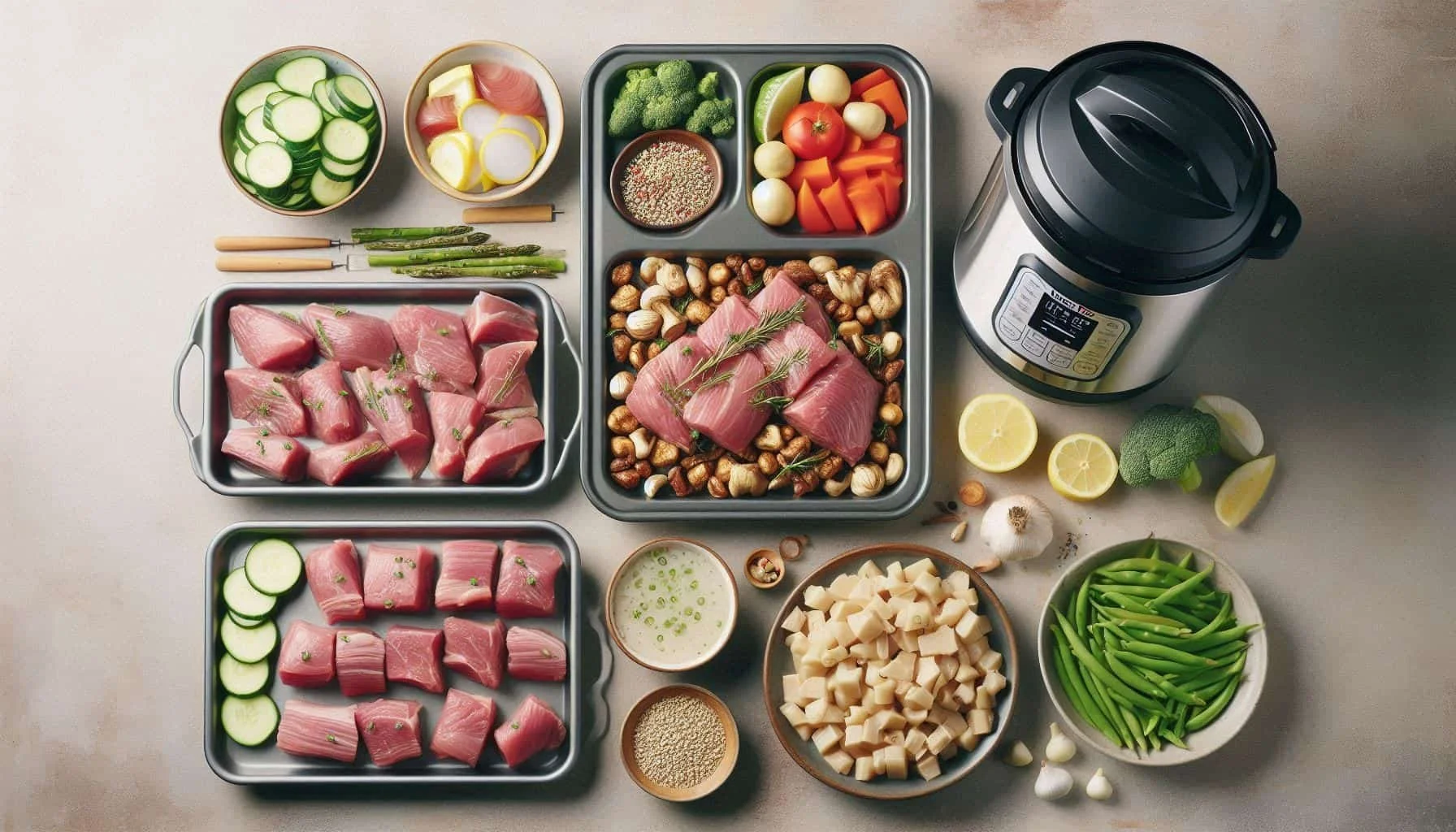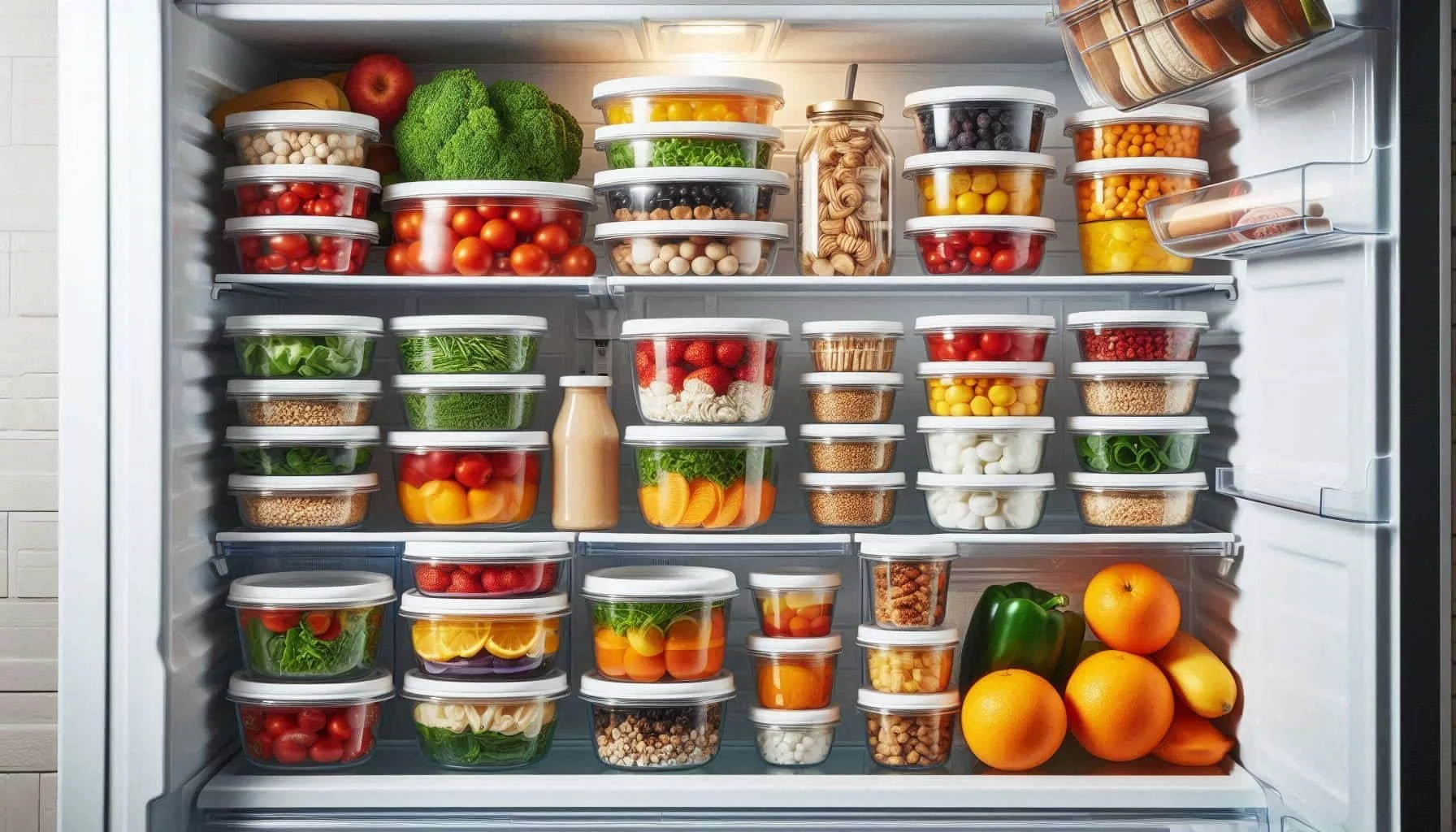Productivity Meal Prep: Fuel Your Work-From-Home Success
Strategic Meal Prep for Peak Remote Work Performance
You've been dominating those video calls and crushing project deadlines (okay, maybe with a few coffee breaks), but your nutrition strategy still resembles chaos theory in practice. Sound familiar? Let's solve this with productivity-focused meal prep that works for real professionals with real deadlines and real cravings for something other than desk snacks.
When you're managing chronic illness while working remotely, meal prep isn't just about convenience—it's about survival. After too many days of eating cereal for dinner because standing to cook triggered my MS symptoms, I developed this energy-efficient system that works even during flares.
The Productivity Crisis: Why Strategic Nutrition Matters for Remote Workers
Remote worker searching empty refrigerator after video call highlighting need for productivity meal prep planning
Picture this scenario: It's Wednesday afternoon. You've just finished back-to-back client calls that required every ounce of mental energy. Your brain feels like it's running on fumes, and you're hungry enough to eat your keyboard. Opening the refrigerator reveals nothing but condiments and that mysterious container from last week's lunch experiment.
Been there, ordered emergency takeout, felt the subsequent energy crash that derailed the rest of your workday. That's precisely why strategic meal prep became my reluctant productivity secret weapon. Not because I transformed into some ultra-organized wellness guru, but because I'm strategically lazy about daily decisions when my cognitive resources should focus on work challenges.
When I committed to serious remote work productivity, I quickly realized my body needed fuel that matched my professional ambitions—not whatever random snacks happened to be within arm's reach during back-to-back meetings. Proper meal prep doesn't just save time and money; it literally protects your cognitive performance and career momentum.
The Harvard Business Review's research on workplace nutrition demonstrates that strategic eating patterns can improve focus by up to 23% and reduce decision fatigue during complex problem-solving tasks.
For those of us with chronic illness, the stakes are even higher. Skipping meals or eating poorly doesn't just affect productivity—it can trigger symptom flares, worsen fatigue, and start a downward spiral that takes days to recover from. When you're managing limited energy, every meal matters. That's why meal prep becomes medical necessity disguised as productivity strategy.
The "Minimal Effort, Maximum Performance" System
Raw protein ingredients organized on sheet pans for efficient meal prep batch cooking for remote workers
Raw ingredients organized on sheet pans ready for bulk preparation
If you're thinking, "But I hate spending time cooking," I completely understand. My culinary skills initially peaked at "microwave instructions and hope for the best." That's why I developed what I call the "Productivity Professional's Meal Prep Strategy".
Start with protein foundations. Select two types weekly (my reliable combination: pre-cooked rotisserie chicken and ground turkey). Prepare ground proteins with minimal seasoning on Sunday. Portion that convenient rotisserie chicken into grab-and-go containers. Done—protein base secured.
Next, embrace the world's most efficient carb preparation: rice cooker or Instant Pot magic. Prepare large batches of brown rice, quinoa, or whatever whole grains don't trigger food boredom. Portion everything immediately. You're halfway to productivity fuel.
For vegetables, befriend the sheet pan methodology. Combine broccoli, bell peppers, zucchini—whatever doesn't make you question your life choices—with olive oil, salt, and pepper. Roast at 425°F for approximately 20 minutes. During roasting time, wash and prepare raw vegetables for quick snacks.
Consider the time investment: this entire productivity-focused process requires about 90 minutes, including the time spent arguing with recipe apps and hunting for container lids that apparently migrate to parallel dimensions.
Chronic Illness Adaptations:
Can't stand for 90 minutes? Neither can I most days. Here's how to modify: - Use a kitchen stool or chair—sitting while prepping is perfectly valid - Break it into 15-minute chunks with rest between - Buy pre-cut vegetables when hand function is compromised - Use lightweight cookware (those cast iron pans can wait for good days) - Batch cook sitting at the table with a portable burner if needed Remember: It's not cheating to buy rotisserie chicken or pre-chopped vegetables. It's strategic energy management.
Beyond Repetitive Meals: Productivity Prep That Doesn't Bore You Senseless
Meal prep containers with varied healthy combinations for sustained remote work productivity and energy
Organized meal prep containers with varied, appetizing combinations
If you've spent time researching productivity nutrition, you might assume successful meal prep requires eating variations of identical meals until you lose the will to live. Let's demolish that misconception immediately.
My breakthrough came when I realized meal prep doesn't mean consuming identical food combinations daily—it means having versatile components ready for strategic mixing and matching based on work demands and energy needs.
Current productivity-focused rotation:
Strategic Proteins:
Rotisserie chicken (store-bought when being realistic about time constraints)
Ground turkey with productivity-supporting spices
Baked salmon (12-minute preparation, perfect for omega-3 brain benefits)
Prepared tofu for plant-based cognitive fuel
Energy-Supporting Carbohydrates:
Brown rice (batch-prepared for easy access)
Sweet potatoes (microwave first, then quick-roast for efficiency)
Whole grain wraps (refrigerated for extended freshness)
Overnight oats in portioned jars (breakfast productivity solved)
Productivity Flavor Enhancers:
Greek yogurt-based sauces for protein and probiotics
Homemade pesto (when feeling ambitious)
Pre-prepared vegetable combinations for easy integration
Strategic spice blends that transform basic ingredients
The game-changing element? "Flavor transformation systems" that convert the same base ingredients into completely different meals. Small containers of pesto, tahini sauce, salsa, or herb blends can make Monday's chicken and rice taste entirely different from Tuesday's preparation.
During one particularly efficient Sunday, I prepared components for Mediterranean-inspired bowls, Mexican-style grain salads, and Asian-influenced wrap combinations—all using variations of identical base ingredients but with different flavor profiles and preparation techniques.
The Container Organization System: Efficiency for People Who Hate Organization
Well-organized refrigerator with systematic meal prep container arrangement for busy professional productivity
Organized refrigerator with systematically arranged glass containers
Let's address food storage logistics honestly. Nothing derails meal prep momentum faster than avalanches of mismatched containers creating kitchen chaos. After one particularly devastating Tupperware collapse that nearly created a safety hazard, I finally invested in coordinated glass container systems.
My simplified organization approach:
All containers must be identical brand for interchangeable lid compatibility
Two sizes maximum: medium for main meals, small for sauces and quick snacks
Glass construction for easy visual identification without opening every container
Stackable design or permanent kitchen banishment
I use removable labels with dates because I've experienced too many "is this still safe to eat?" moments that resulted in apologetic messages to colleagues explaining productivity delays.
Pro tip that revolutionized my system: prepare individual components rather than complete meals for maximum flexibility. Having separate containers of prepared chicken, rice, roasted vegetables, and fresh produce allows assembling different meal combinations throughout the week based on actual cravings rather than Sunday predictions about Wednesday preferences.
The Energy Conservation Kitchen Setup
The Energy Conservation Kitchen Setup
When you have chronic illness, your kitchen needs to work WITH your limitations, not against them. After too many days of skipping meals because I couldn't reach ingredients or stand long enough to prep, I reorganized everything for maximum accessibility.
Counter-Height Prep Station:
Cutting boards at seated height
Anti-fatigue mats for necessary standing
Everything within arm's reach—no stretching or bending - Jar opener mounted under cabinet for weak grip days
The Chronic Illness Prep Kit:
Ergonomic peeler and chopper
Lightweight mixing bowls
Electric can opener
Food processor for days when chopping is impossible
Disposable gloves for sensory issues or joint protection
The goal isn't Pinterest-worthy organization—it's functional accessibility on your worst days.
Strategic Snacking: Preventing Productivity-Killing Hunger Crashes
Healthy, portable snacks arranged in grab-and-go containers
Honest assessment: the time between meals is where both productivity AND symptom management often collapse. I learned this during an MS flare when I got so focused on work that I forgot to eat, triggering worse fatigue that knocked me out for two days. Never again.
For chronic illness warriors, strategic snacking isn't optional—it's medication timing, blood sugar stability, and energy management rolled into one. Missing a snack can mean the difference between finishing your workday and crashing at 2 PM.Now I approach snack preparation with the same strategic thinking as project planning. My current productivity-supporting rotation:
Greek yogurt portions with separate containers of berries and honey
Hard-boiled eggs (the original grab-and-go protein convenience)
Cut vegetables with individual hummus portions
Energy combinations (oats, nut butter, honey, protein powder, whatever else supports sustained energy)
The critical factor is making these as convenient as possible. Pre-portion everything strategically. Your future hungry self has approximately zero willpower and even less patience for food preparation during deadline pressure.
I maintain a designated "productivity fuel shelf" in my refrigerator where post-meeting snack options live permanently. Nothing interferes with my protein shake and banana after intense focus sessions. Nothing. My roommate learned this lesson definitively when she "borrowed" my last prepared protein shake. We don't discuss the incident, but it never repeated.
Precision Nutrition's comprehensive research confirms that strategic snacking patterns significantly impact cognitive performance and sustained energy throughout demanding workdays.
Managing Meal Prep Fatigue: Rescue Strategies for Sustainability
Professional adding fresh ingredients to meal prep base components for sustained work productivity and energy
Healthy, portable snacks arranged in grab-and-go containers
Three weeks into my first serious meal prep commitment, I hit the wall hard. I couldn't contemplate another pre-prepared protein serving without experiencing genuine existential dread. Rather than abandoning the entire system (and my productivity goals), I developed sustainable workaround strategies:
The Flare Day Reality Check:
Some weeks, chronic illness wins. You'll have every intention of meal prepping and then spend Sunday in bed.
Here's your hierarchy of acceptable alternatives:
Best case: Use that grocery delivery app guilt-free
Good enough: Protein shakes and pre-made sandwiches
Survival mode: Ensure/Boost and crackers
No shame zone: Order takeout for the week The goal is nutrition, not perfection. Fed is better than not fed, always.
The "Semi-Prepared" Compromise: Grocery store rotisserie chicken, pre-cut vegetable mixtures, microwaveable grain packets. Not optimal for budget consciousness but preserves sanity and productivity momentum.
The Strategic Freezer Approach: Prepare double quantities every other week and freeze half in individual portions. Future You will experience profound gratitude.
The "One Fresh Meal" Policy: Prepare productivity basics for most meals but reserve space for one freshly-prepared dinner when craving culinary creativity.
The Meal Exchange Network: Find fellow remote workers with similar productivity goals and occasionally swap prepared meals. Someone else's cooking always tastes superior, even using essentially identical ingredients.
My personal sustainability strategy involves "theme variations" using meal prep components but feeling special—like Productivity Tuesday using prepared ground turkey, or Focus Bowl Thursday where I combine different prepared ingredients with new sauce combinations.
Real Talk: Sustainable Productivity Nutrition for Long-Term Success
Unhealthy snack and sad remote worker woman vs Healthy snacks and radiant worker woman
After extensive trial, error, and container mishaps, here's what I know definitively: the "perfect" meal prep system is whatever you'll actually maintain consistently. Mine isn't Instagram-worthy. Sometimes it involves pre-marinated proteins from grocery stores and steamable vegetable packages. And that's completely acceptable for sustained productivity.
A Note for My Chronic Illness Community
If meal prep feels overwhelming, start smaller than small. Prep just hard-boiled eggs this week. Or buy pre-portioned hummus. Or order those meal replacement shakes that actually taste decent. Every tiny step toward consistent nutrition is a victory when you're managing symptoms. Your meal prep doesn't have to look like anyone else's—it just has to work for YOUR body and YOUR energy levels.
Living with chronic illness taught me that "perfect" meal prep is whatever keeps you nourished through symptom fluctuations. Some weeks I'm batch-cooking like a pro. Other weeks, I'm living on protein shakes and apple slices because that's all I can manage. Both are valid. Both are taking care of yourself.Your remote work career isn't a sprint—it's an endurance event with strategic nutrition breaks. Meal prep should evolve with your professional demands, schedule changes, and energy requirements. Some weeks you'll prepare like a culinary professional; others you'll rely on emergency frozen portions and quality protein bars.
What matters most is creating systems that fuel your work performance, support cognitive recovery, and maintain consistency. Because ultimately—the best productivity results come from boring, sustainable consistency in both your work habits AND your nutrition choices.
So start simply and build gradually. Prep just proteins one week. Add strategic carbohydrates the next. Work toward comprehensive systems. Take shortcuts when deadlines demand. Forgive yourself for the week you rely on takeout three times. Remember that every Sunday offers a fresh start—new opportunities to fill your refrigerator with good intentions and actual fuel to support them.
Your future post-deadline, cognitively depleted self deserves the very best nutrition you can provide—even if sometimes that means rotisserie chicken and microwaved sweet potatoes because you exhausted your meal prep energy on work priorities. Been there, eaten that, still maintained productivity momentum.
Affiliate disclaimer: As an Amazon Associate, I earn from qualifying purchases. I only recommend kitchen tools and productivity resources I've personally tested in real remote work situations.






